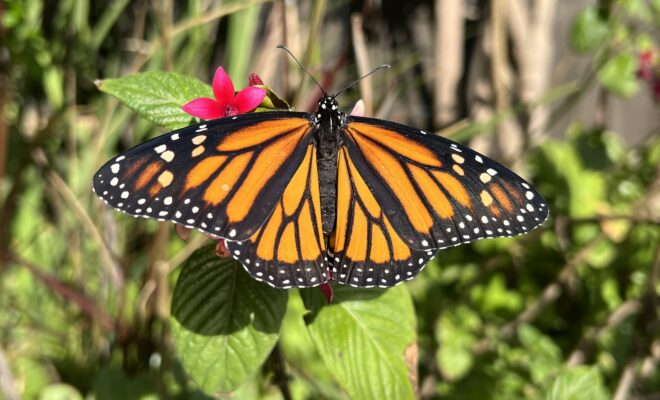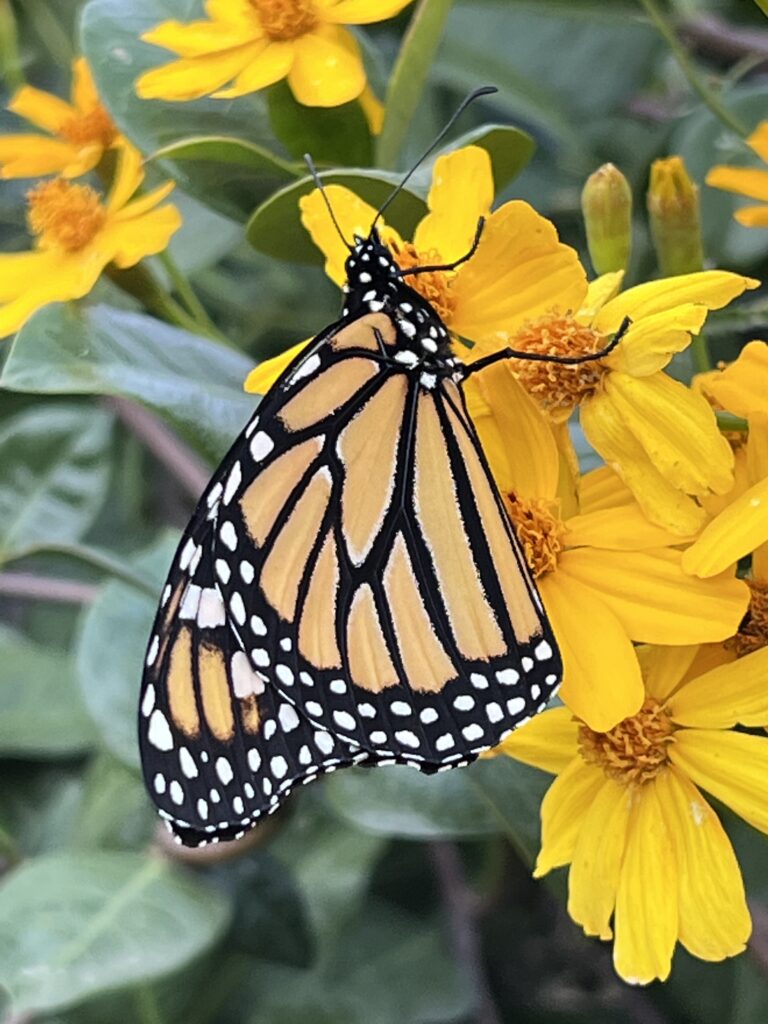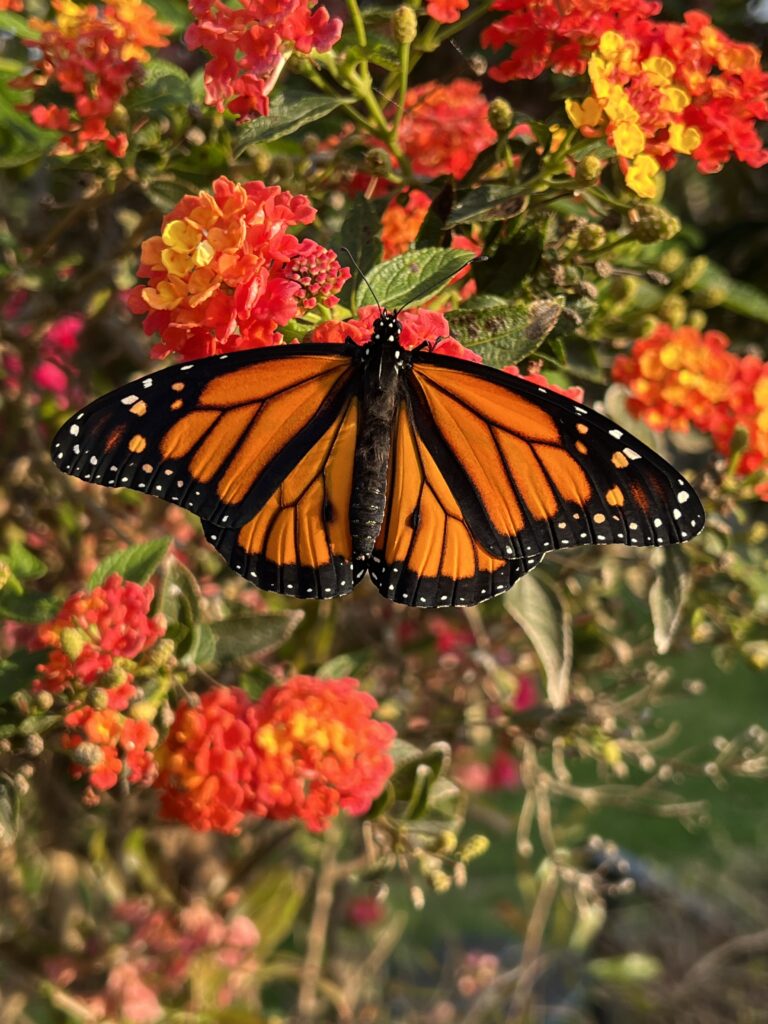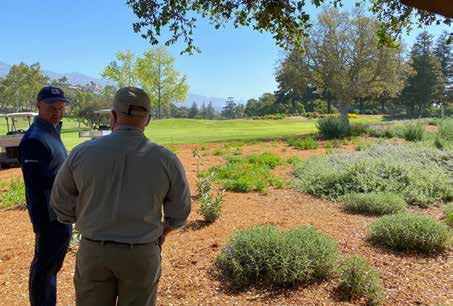The Monarchs of Morro Bay: Endangered Butterflies Thrive at a Course Managed For Their Protection and Preservation

If you’re standing behind the No. 9 tees at Morro Bay GC, you’re gazing down upon one of the most glorious course views in the region: the hills of Montaña de Oro to the south, the estuary and dunes to the west, the incredible hulk of Morro Rock to the north.
But there’s another view from No. 9 that’s every bit as glorious as the coastal vista. Turn around and gaze into the eucalyptus grove that crests the slope behind the tee box, and you’re likely to see the fluttering wings of some 3,000 monarch butterflies. You might even hear those wings.
Now look more closely into the trees. Vast clusters of monarchs cling to the high branches, almost indistinguishable from the trees if their wings are folded. But then a few wings unfold, and as the late-morning sun warms the air, more and more butterflies flutter from the trees, their orange and black contrasting with the deep blue of the sky above.
Important Habitat
Morro Bay GC is blessed to be one of California’s most important overwintering sites for western monarch butterflies, whose numbers have dwindled by at least 90 percent since the 1990s. The butterflies start arriving in October at the destination of their annual migration (successive generations migrate westward over the course of the year) and linger in the grove until March. But why here?
“It’s a combination of factors,” says Kingston Leong, a professor emeritus of entomology at nearby Cal Poly San Luis Obispo. Leong frequently helps guide free public tours of the monarch grove during the overwintering season. “They come to the coast (from points east) for the relative humidity, which is extremely important for monarchs. But they also need protection from the wind, which is why they cluster in the eucalyptus trees. At the same time, they need the right amount of sunlight for warmth.”
All of which Morro Bay GC provides. In fact, the course is managed specifically to accommodate its winter visitors. Josh Heptig, director of golf course operations for San Luis Obispo County Parks & Recreation, sees to that. “We’re stewards of the land here,” says Heptig. As such, Heptig has his hands full.
“At one point there would be as many as 100,000 monarchs in Morro Bay,” Heptig says. “But we’ve lost 2,500 trees since the late ’90s, and that continues.”
The trees in question are Monterey pines, which once provided a critical protective buffer between the coastal wind and the eucalyptus grove. That was before the pines succumbed to pitch canker, a fungal infection that is decimating Monterey pines all along the coast.
Heptig’s response: Plant more trees! Enlisting the help and buy-in of the community, the First Tee youth development program and local schoolchildren (including his own), Heptig organized the planting of hundreds of Monterey cypress trees to help shelter the monarch grove from the northwest winds that sweep down the coast. It’s a long-range solution, but 10 years later, the trees, which are resistant to pitch canker, have grown enough to have some buffering effect. Heptig also ensures that the eucalyptus trees are trimmed to permit just the right amount of sunlight, and that the course uses minimal pesticides that might affect the monarchs.
To Heptig, raising public awareness is just as critical as managing the botany of his course. To that end, Heptig and Leong’s weekend tours are open to non-golfers and golfers alike, so that everyone can gain an appreciation for the beauty — and the plight — of western monarchs.
“In helping the monarchs, we’re also trying to change the impression of golf for nongolfers,” Heptig says. As many as 150 people have joined a single tour — on some days, butterfly-watchers exceed the number of golfers on the course — and Heptig sees lots of return visitors who come back year after year to check on the monarchs.
The tour entails a short uphill walk alongside the driving range. A cart path ensures access for those who can’t make the walk, and Heptig hopes to raise funds to someday cover that pathway. “It’s important to us to be inviting,” he adds. “We’re public, after all. The course is owned by the state. We often hear, ‘I didn’t know golf could be like this.’”
Courses Doing Their Part
San Luis Obispo County is blessed with two other golf-adjacent monarch habitats. In Nipomo, homeowners at Monarch Dunes CC have set aside a 19-acre eucalyptus grove and planted Monterey cypress trees to protect it. And on the border of Grover Beach and Pismo Beach, golfers playing Pismo Beach GC are a chip shot away from the Central Coast’s most flourishing butterfly site — the Pismo State Beach Monarch Grove, which this winter is drawing more than 24,000 monarchs. The grove is just outside the northern edge of the nine-hole course.
Beyond these overwintering sites, golf courses throughout SoCal are doing their part to help the endangered monarchs. The butterflies rely on a single source of food, milkweed, to sustain their caterpillars and to serve as a nursery for butterfly eggs. Because development in the West has severely limited the availability of the critical plant, more than 30 courses have joined Monarchs in the Rough, a program sponsored by Audubon International and the Environmental Defense Fund to encourage planting of native milkweed.
Meanwhile, back in Morro Bay, the afternoon sun has warmed the air, and so many monarchs have fluttered down to the fairway turf to sip dew that they rise in a cloud as golfers approach. Kingston Leong explains that they drink to metabolize their fat reserves in advance of mating toward winter’s end — at which time they’ll flutter away, migrate east and return a few generations later for another fall-winter sojourn in Morro Bay.













